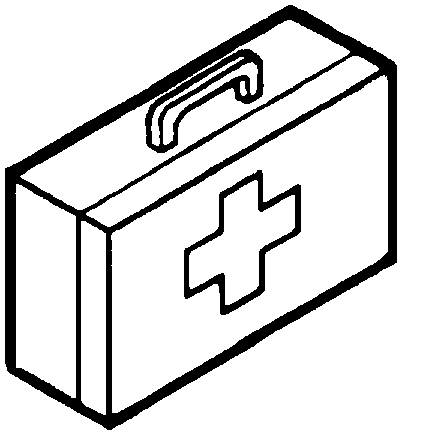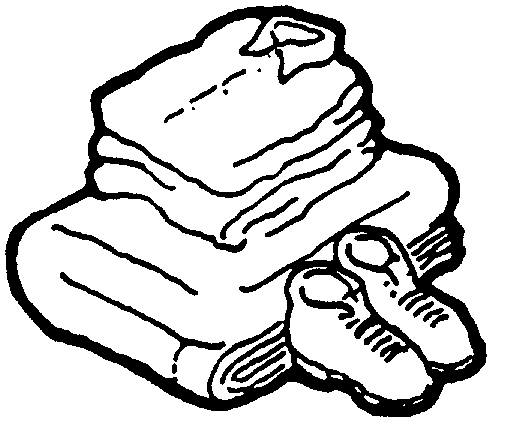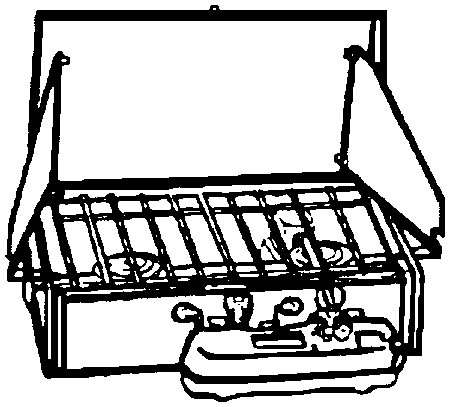Emergency Supply Checklists for Alaskans
SAL-00007 View this publication in PDF form to print or download.
Alaska is an area of natural beauty and magnificent landscapes. Natural forces loom large in our history and in our daily lives. Because of this, our lives are subject to a wide range of natural disasters. Floods, earthquakes, wildfires, severe storms, tidal waves (tsunamis) and volcanic eruptions are normal routines. Being prepared for these eventualities is just a matter of a little time and effort to pull together some supplies to help you adjust to emergencies without undue stress. Stocking up now on emergency supplies can add to your safety and comfort during and after any natural disaster. Store enough supplies for at least 72 hours.
1. Basic 72-Hour Emergency Evacuation Kit
For emergencies requiring home evacuation.
Container type: A large, sturdy backpack and (if necessary) a sturdy plastic bin, able to be carried by one or two adults in case of evacuation.
Location options: In your car (not parked in a garage) or near an exterior door of your home. Consider locating a second supply away from your home: at work, on a boat, or at a friend’s or relative’s house.
Supplies
Survival:
- 2 quarts to 1 gallon of water per person, per day*
- First aid kit (see list #2)
- 3 days of nonperishable food per person, with can opener if needed*
- Infant supplies and food*
- Blanket or sleeping bag for each person
- Local maps, community/municipality/public safety contact information**
- Medications (7-day supply) and glasses, special medical supplies**
- Pet supplies, food and water*
- Multi-purpose tool with knife
- Fire-starting supplies
- Signal whistle on lanyard (1 per person)
- Cash, coins, spare credit card**
For Sanitation:
- Garbage bags, plastic zippered bags
- Personal hygiene items (cleaning wipes, feminine supplies, soaps, toothbrushes & paste, toilet paper)
Cooking:
- Camp stove with fuel
- Mess kits, paper towels, dish detergent, aluminum foil
- Matches in waterproof container
- Small container of chlorine bleach and a medicine dropper
Safety & Comfort:
- Tent
- Rain ponchos, thermal blankets
- N95 masks and multi-layer, washable masks, 3 days’ supply for each person.
- Duct tape, tarp or plastic sheeting
- Flashlight with batteries
- Insect repellent and sunscreen
- Books, games, puzzles for children
- Change of clothes for each person, including sturdy shoes and gloves**
- Air-activated hand warmers
- Extra set of car and house keys**
Communication:
- Cell phone chargers**
- Paper, pencil, permanent marker
- Battery-powered or hand-crank radio (NOAA Weather Radio if possible), spare batteries
- Copies of important documents: insurance, bank, and family information, identification**
- Copy of family travel/evacuation routes and communication plan**
2. First Aid Kits
Make your own or purchase ready-made kits; multiple kits are recommended.
Container: Sturdy and appropriate for the location.
Location recommendations: One in home, one in car, one in 72-Hour Emergency Supply Kit
Supplies: (make your own or purchase one with the following items)
 2 absorbent compress dressings (5 x 9 inches)
2 absorbent compress dressings (5 x 9 inches)- 25 adhesive bandages (assorted sizes)
- 1 adhesive cloth tape (10 yards x 1 inch)
- 5 antibiotic ointment packets (approximately 1 gram)
- 5 antiseptic wipe packets
- 2 packets of aspirin (81 mg each)
- 1 blanket (space blanket)
- 1 breathing barrier (with one-way valve)
- 1 instant cold compress
- 2 pair of non-latex gloves (size: large)
- 2 hydrocortisone ointment packets (approximately 1 gram each)
- Scissors
- 1 roller bandage (3 inches wide)
- 1 roller bandage (4 inches wide)
- 5 sterile gauze pads (3 x 3 inches)
- 5 sterile gauze pads (4 x 4 inches)
- Oral thermometer (non-mercury/nonglass)**
- 2 triangular bandages
- Tweezers
- First aid instruction booklet
3. Youth Emergency Evacuation Kit
For emergencies requiring evacuation from the home, for kids who are able to carry their own gear.
Container: A backpack able to be carried by the specific child in case of evacuation.
Location options: With the Basic 72-Hour Emergency Evacuation Kit
Supplies: (will depend on child, basic kit can be reduced by putting some of those items in youth backpack)
- 1 quart of water*
- 1-3 days of non-perishable food (in easy-open packaging)*
- Signal whistle on lanyard
- Small first aid kit with prescription medications (3-day supply) and glasses**
- Personal hygiene items (wipes, feminine supplies, soaps, toothbrush & paste, toilet paper)
- Copy of family travel routes and emergency communication plan**
- Copy of ID**
- Cash and coins
- Books, games, puzzles
- Blanket
- Change of clothes and shoes (assume winter weather)**
- Rain poncho
- Air-activated hand warmers
- Extra set of house keys**
- Paper, pencil, permanent marker
4. Additional Emergency Supply Kit
For in-home emergencies, to reduce use of evacuation kit supplies, or supplement them.
Container: Large, sturdy bin; specific closet or storage area.
Location options: In a central location of the home, that everyone is aware of.
Supplies:
 Spare ABC fire extinguisher
Spare ABC fire extinguisher- Additional water, several gallons for each person*
- N95 or surgical masks
- Duct tape and plastic sheeting
- Coil of ½-inch rope
- Flashlight with extra batteries
- Tools: ax, shovel, broom, woodcutting saw, screwdriver, pliers, hammer, scissors
- Any special tools needed for turning off propane, diesel, gas (crescent wrench, pipe wrench)
- Unopened bottles of hydrogen peroxide and household bleach
- Toilet paper
- Garden hose for firefighting and siphoning fuel
- Blankets
- Plastic tape and sheeting
- Keep vehicles, generators, and heating fuel tanks filled with fuel
- Keep additional batteries of all sizes in the refrigerator for longer life
5. By-the-Bed Emergency Kit
For in-home emergencies or evacuation late at night.
Container: Small duffel or bag with handles
Location options: Looped over bedroom inside doorknob or bed frame, or on a hook next to the bed.
Supplies:
 Sturdy slip-on shoes with thick soles
Sturdy slip-on shoes with thick soles- Flashlight (batteries inside, check them every 3 months)**
- One set of warm clothes, including socks and gloves
6. Emergency Food Pantry
Secondary supply of shelf-stable, nonperishable food for use in case of extended shelter-at-home orders or regional emergency resulting in a shortage of commercially available food supplies.
Container: Anything from a large plastic bin in a closet to a spare room or cellar, include a freezer, if possible.
Location options: Anywhere there is room; outside of the kitchen is preferable.
Supplies:
For a “rotation pantry:”
Step 1: Make a list of 3–30 days of the recipes/meals you regularly eat create a master ingredients list.
Step 2: On each regular shopping trip, buy extra of the shelf-stable goods listed on the master ingredients list. Buy as many as you can comfortably afford, until your emergency pantry is full.
Step 3: Prior to each regular shopping trip, fill daily pantry from emergency pantry; shop to refill the emergency pantry. This will ensure that your emergency pantry stays stocked with fresh items.
For an additional, longer term pantry:
Step 4: Buy bulk items with a very long shelf life such as white rice, brown rice, dry beans, dehydrated meals, dry milk, and multi-vitamins. Keep in air-tight, pest-proof containers. Don’t rotate these foods, but instead replace every 5–10 years.
7. Short-Term Power Outage Supply Checklist
 Be prepared for outages of 2–12 hours.
Be prepared for outages of 2–12 hours.
Container: Box, bin, or designated cupboard (or use the cooler)
Location options: In a central location that everyone is aware of.
Supplies:
- Flashlights and batteries (not candles)**
- Non-decorative oil lamps and smokeless lamp oil, solar-recharging lanterns
- Cooler for ice from freezer, if you have an icemaker
- Have a “landline,” non-cordless phone in the house
8. Long-Term Power Outage Supply Checklist
Prepare for outages of more than 12 hours
Container: As appropriate for the items but a designated cupboard/bin for all is recommended
Location options: Items might be located throughout the house but a central location is recommended.
Supplies:
 Coolers (inexpensive Styrofoam ones work well)
Coolers (inexpensive Styrofoam ones work well)- Digital, instant-read thermometer, to check internal temperature of food
- Propane camp stove (or ability to use propane kitchen stove without electricity)
- Large bag of food-grade salt (preferably canning salt) for preserving meats and vegetables
- Pressure canner, for preserving frozen meats, vegetables, and seafood
- Waterbath canner, for preserving frozen fruits and berries
- Food preservation how-to guide
- Blankets and sweaters
- Install a wood-burning heating appliance in your home, if you don’t already have one
- Get a generator for back-up electrical heat and/ or refrigeration/freezer, and if someone has electrical medical equipment
*Check food at least once a year to confirm freshness, replace water with fresh.
** Check/revise these at least once a year to ensure the information/supplies/equipment are current.
Sarah Lewis, Extension Faculty, Health, Home and Family Development. Originally prepared by Richard Seifert, former Extension Energy and Housing Specialist.
Revised October 2020
